Copyright © 2003 Prentice-Hall, Inc. Topic 5. Market
















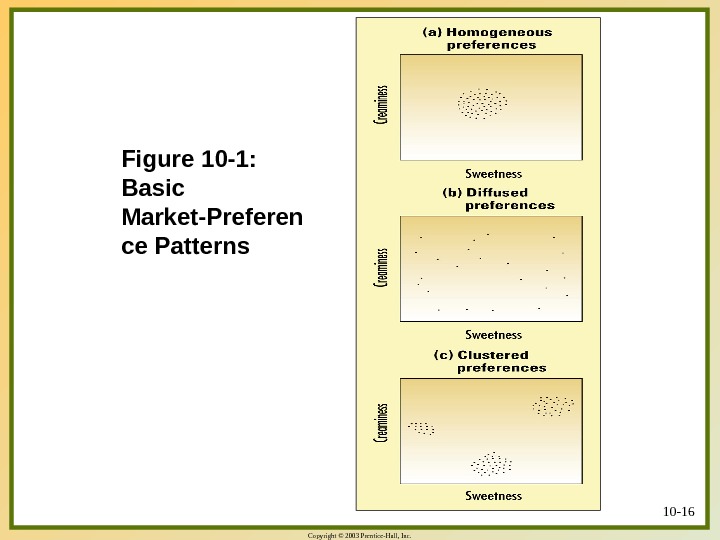



















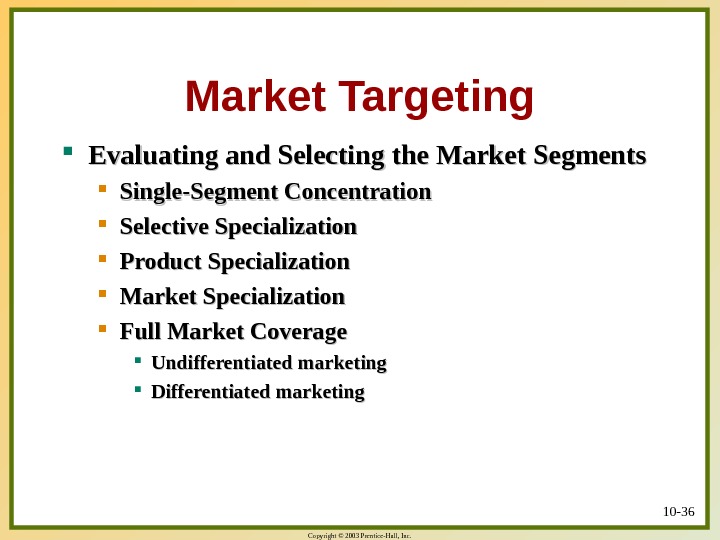

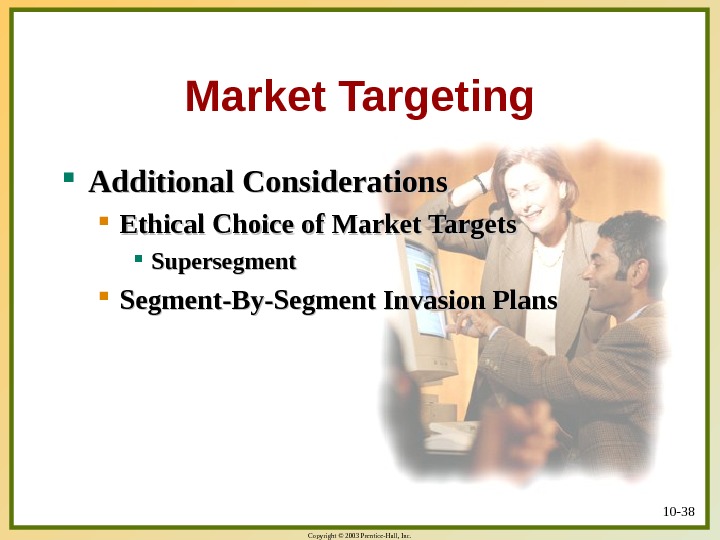



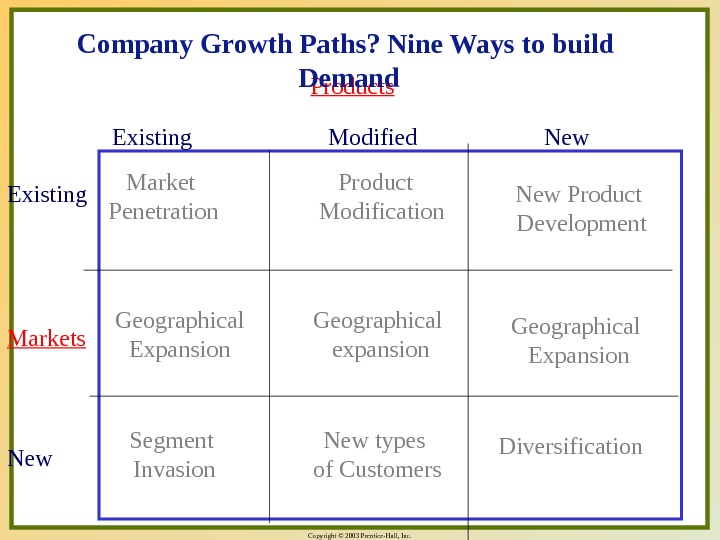



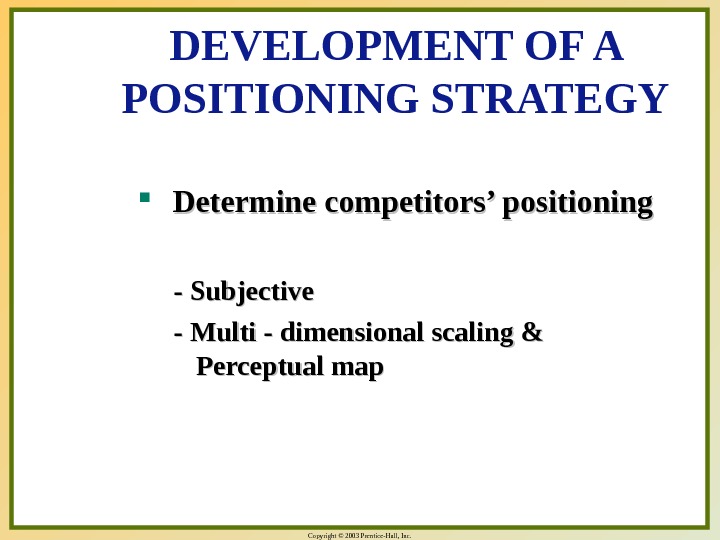



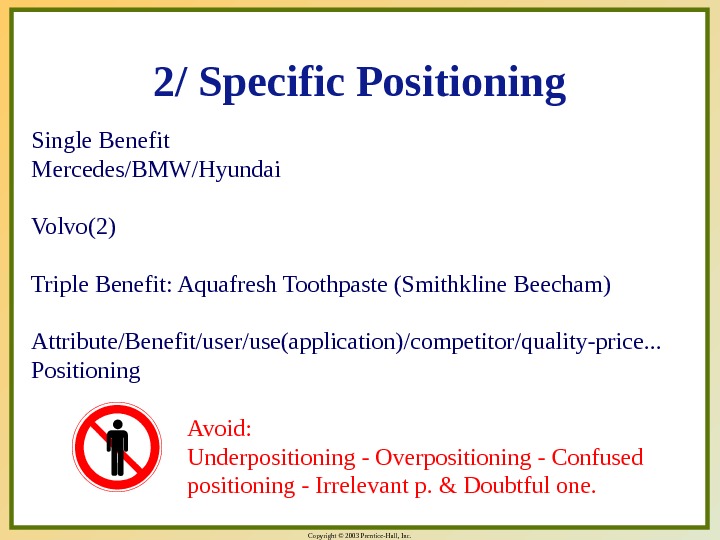




topic_4_market_segmentation.ppt
- Размер: 1.5 Mегабайта
- Количество слайдов: 54
Описание презентации Copyright © 2003 Prentice-Hall, Inc. Topic 5. Market по слайдам
 Copyright © 2003 Prentice-Hall, Inc. Topic 5. Market segmentation. Positioning. Targeting. Marketing course 10 —
Copyright © 2003 Prentice-Hall, Inc. Topic 5. Market segmentation. Positioning. Targeting. Marketing course 10 —
 Copyright © 2003 Prentice-Hall, Inc. 10 — 2 Kotler on Marketing ““ Don’t buy market share. Figure out how to earn it. ”
Copyright © 2003 Prentice-Hall, Inc. 10 — 2 Kotler on Marketing ““ Don’t buy market share. Figure out how to earn it. ”
 Copyright © 2003 Prentice-Hall, Inc. 10 — 3 Chapter Objectives We focus on the following questions: How can a company identify the segments that make up a market? What criteria can a company use to choose the most attractive target markets?
Copyright © 2003 Prentice-Hall, Inc. 10 — 3 Chapter Objectives We focus on the following questions: How can a company identify the segments that make up a market? What criteria can a company use to choose the most attractive target markets?
 Copyright © 2003 Prentice-Hall, Inc. Segmented market Target market. Mass market … an amorphous mass Why Segment? Mass – segment — target
Copyright © 2003 Prentice-Hall, Inc. Segmented market Target market. Mass market … an amorphous mass Why Segment? Mass – segment — target
 Copyright © 2003 Prentice-Hall, Inc. Levels of Market Segmentation. Individual Local Niche Segment None Mass marketing. Identifiable group, differentiated product. Narrowly defined group; needs not currently met. Tailored products/services to local customer. Segments of 1: customised
Copyright © 2003 Prentice-Hall, Inc. Levels of Market Segmentation. Individual Local Niche Segment None Mass marketing. Identifiable group, differentiated product. Narrowly defined group; needs not currently met. Tailored products/services to local customer. Segments of 1: customised
 Copyright © 2003 Prentice-Hall, Inc. Niches: Ferrari-Lamborghini/Porsche/Aston Martin Advantages of niches? Mass customized marketing # customized marketing
Copyright © 2003 Prentice-Hall, Inc. Niches: Ferrari-Lamborghini/Porsche/Aston Martin Advantages of niches? Mass customized marketing # customized marketing
 Copyright © 2003 Prentice-Hall, Inc. Viability of segment affected by: market factors Size & growth rate identity relevance (to product) access intensity of competition New entrants & substitute products Bargaining power of customers & suppliers Political/social & Environmental factors And ……Segmentation Viability
Copyright © 2003 Prentice-Hall, Inc. Viability of segment affected by: market factors Size & growth rate identity relevance (to product) access intensity of competition New entrants & substitute products Bargaining power of customers & suppliers Political/social & Environmental factors And ……Segmentation Viability
 Copyright © 2003 Prentice-Hall, Inc. Demographic Geographic Psychographic Age Country Personality Gender Region Lifestyle Family life cycle City size Activities Occupation Population density Social Class Education Continent Religion Climate Nationality income Consumer Segmentation
Copyright © 2003 Prentice-Hall, Inc. Demographic Geographic Psychographic Age Country Personality Gender Region Lifestyle Family life cycle City size Activities Occupation Population density Social Class Education Continent Religion Climate Nationality income Consumer Segmentation
 Copyright © 2003 Prentice-Hall, Inc. Behaviour Benefits sought Purchase occasion Purchase behaviour Usage Perceptions and beliefs Consumer Segmentation (2)
Copyright © 2003 Prentice-Hall, Inc. Behaviour Benefits sought Purchase occasion Purchase behaviour Usage Perceptions and beliefs Consumer Segmentation (2)
 Copyright © 2003 Prentice-Hall, Inc. Ramstor Magnum Examples
Copyright © 2003 Prentice-Hall, Inc. Ramstor Magnum Examples
 Copyright © 2003 Prentice-Hall, Inc. Organizational Segmentation Macro-segmentation Micro-segmentation Organizational size Industry Geographic location Purchasing Organizational Innovativeness Source: Jobber, 2001, p. 199 D-M Unit structure D-M Process. Choice criteria Buy Class
Copyright © 2003 Prentice-Hall, Inc. Organizational Segmentation Macro-segmentation Micro-segmentation Organizational size Industry Geographic location Purchasing Organizational Innovativeness Source: Jobber, 2001, p. 199 D-M Unit structure D-M Process. Choice criteria Buy Class
 Copyright © 2003 Prentice-Hall, Inc. 10 — 12 Target Marketing Target marketing requires marketers to take three major steps: Identify and profile distinct groups of buyers who differ in their needs and preferences (market segmentation). Select one or more market segments to enter (market targeting). For each target segment, establish and communicate the key distinctive benefit(s) of the company’s market offering (market positioning).
Copyright © 2003 Prentice-Hall, Inc. 10 — 12 Target Marketing Target marketing requires marketers to take three major steps: Identify and profile distinct groups of buyers who differ in their needs and preferences (market segmentation). Select one or more market segments to enter (market targeting). For each target segment, establish and communicate the key distinctive benefit(s) of the company’s market offering (market positioning).
 Copyright © 2003 Prentice-Hall, Inc. 10 — 13 Levels and Patterns of Market Segmentation Levels of Market Segmentation Mass marketing Micromarketing Segment marketing Market segment Sector Flexible market offering Naked solution Discretionary options
Copyright © 2003 Prentice-Hall, Inc. 10 — 13 Levels and Patterns of Market Segmentation Levels of Market Segmentation Mass marketing Micromarketing Segment marketing Market segment Sector Flexible market offering Naked solution Discretionary options
 Copyright © 2003 Prentice-Hall, Inc. 10 — 14 Levels and Patterns of Market Segmentation Niche Marketing Niche Local Marketing Individual Customer Marketing Mass-customization Choiceboard Customerization Segments Individuals
Copyright © 2003 Prentice-Hall, Inc. 10 — 14 Levels and Patterns of Market Segmentation Niche Marketing Niche Local Marketing Individual Customer Marketing Mass-customization Choiceboard Customerization Segments Individuals
 Copyright © 2003 Prentice-Hall, Inc. 10 — 15 Levels and Patterns of Market Segmentation Patterns for Market Segmentation Preference segments Homogeneous preferences Diffused preferences Clustered preferences Natural market segments Concentrated marketing
Copyright © 2003 Prentice-Hall, Inc. 10 — 15 Levels and Patterns of Market Segmentation Patterns for Market Segmentation Preference segments Homogeneous preferences Diffused preferences Clustered preferences Natural market segments Concentrated marketing
 Copyright © 2003 Prentice-Hall, Inc. 10 — 16 Figure 10 -1: Basic Market-Preferen ce Patterns
Copyright © 2003 Prentice-Hall, Inc. 10 — 16 Figure 10 -1: Basic Market-Preferen ce Patterns
 Copyright © 2003 Prentice-Hall, Inc. 10 — 17 Levels and Patterns of Market Segmentation Procedure Needs-based market segmentation approach Market partitioning Brand-dominant hierarchy Nation-dominant hierarchy
Copyright © 2003 Prentice-Hall, Inc. 10 — 17 Levels and Patterns of Market Segmentation Procedure Needs-based market segmentation approach Market partitioning Brand-dominant hierarchy Nation-dominant hierarchy
 Copyright © 2003 Prentice-Hall, Inc. 10 — 18 Table 10 -1: Steps in Segmentation Process Description 1. Needs-Based Segmentation Group customers into segments based on similar needs and benefits sought by customer in solving a particular consumption problem. 2. Segment Identification For each needs-based segment, determine which demographics, lifestyles, and usage behaviors make the segment distinct and identifiable (actionable). 3. Segment Attractiveness Using predetermined segment attractiveness criteria (such as market growth, competitive intensity, and market access), determine the overall attractiveness of each segment. 4. Segment Profitability Determine segment profitability. 5. Segment Positioning For each segment, create a “value proposition” and product-price positioning strategy based on that segment’s unique customer needs and characteristics. See text for complete table
Copyright © 2003 Prentice-Hall, Inc. 10 — 18 Table 10 -1: Steps in Segmentation Process Description 1. Needs-Based Segmentation Group customers into segments based on similar needs and benefits sought by customer in solving a particular consumption problem. 2. Segment Identification For each needs-based segment, determine which demographics, lifestyles, and usage behaviors make the segment distinct and identifiable (actionable). 3. Segment Attractiveness Using predetermined segment attractiveness criteria (such as market growth, competitive intensity, and market access), determine the overall attractiveness of each segment. 4. Segment Profitability Determine segment profitability. 5. Segment Positioning For each segment, create a “value proposition” and product-price positioning strategy based on that segment’s unique customer needs and characteristics. See text for complete table
 Copyright © 2003 Prentice-Hall, Inc. 10 — 19 Levels and Patterns of Market Segmentation Effective Segmentation Measurable Substantial Accessible Differentiable Actionable
Copyright © 2003 Prentice-Hall, Inc. 10 — 19 Levels and Patterns of Market Segmentation Effective Segmentation Measurable Substantial Accessible Differentiable Actionable
 Copyright © 2003 Prentice-Hall, Inc. 10 — 20 Segmenting Consumer and Business Markets Bases for Segmenting Consumer Markets
Copyright © 2003 Prentice-Hall, Inc. 10 — 20 Segmenting Consumer and Business Markets Bases for Segmenting Consumer Markets
 Copyright © 2003 Prentice-Hall, Inc. 10 — 21 Table 10 -2: Major Segmentation Variables for Consumer Markets Geographic Region Pacific, Mountain, West North Central, West South Central, East North Central, East South Central, South Atlantic, Middle Atlantic, New England City or metro size Under 5, 000; 5, 000 -20, 000; 20, 000 -50, 000; 50, 000 -100, 000; 100, 000 -250, 000; 250, 000 -500, 000; 500, 000 -1, 000, 000; 1, 000, 000 -4, 000, 000; 4, 000, 000 or over Density Urban, suburban, rural Climate Northern southern Demographic Age Under 6, 6 -11, 12 -19, 20 -34, 35 -49, 50 -64, 65+ Family size 1 -2, 3 -4, 5+ See text for complete table
Copyright © 2003 Prentice-Hall, Inc. 10 — 21 Table 10 -2: Major Segmentation Variables for Consumer Markets Geographic Region Pacific, Mountain, West North Central, West South Central, East North Central, East South Central, South Atlantic, Middle Atlantic, New England City or metro size Under 5, 000; 5, 000 -20, 000; 20, 000 -50, 000; 50, 000 -100, 000; 100, 000 -250, 000; 250, 000 -500, 000; 500, 000 -1, 000, 000; 1, 000, 000 -4, 000, 000; 4, 000, 000 or over Density Urban, suburban, rural Climate Northern southern Demographic Age Under 6, 6 -11, 12 -19, 20 -34, 35 -49, 50 -64, 65+ Family size 1 -2, 3 -4, 5+ See text for complete table
 Copyright © 2003 Prentice-Hall, Inc. 10 — 22 Segmenting Consumer and Business Markets Bases for Segmenting Consumer Markets Geographic Segmentation Demographic Segmentation Age and Life-Cycle Stage
Copyright © 2003 Prentice-Hall, Inc. 10 — 22 Segmenting Consumer and Business Markets Bases for Segmenting Consumer Markets Geographic Segmentation Demographic Segmentation Age and Life-Cycle Stage
 Copyright © 2003 Prentice-Hall, Inc. 10 — 23 An easily identifiable demographic group which is often targeted by marketers is college students. Do you think this is influenced more by a common economic status of the target group, geographic concentration of a specific age group, or some other factor(s)?
Copyright © 2003 Prentice-Hall, Inc. 10 — 23 An easily identifiable demographic group which is often targeted by marketers is college students. Do you think this is influenced more by a common economic status of the target group, geographic concentration of a specific age group, or some other factor(s)?
 Copyright © 2003 Prentice-Hall, Inc. 10 — 24 Segmenting Consumer and Business Markets Life Stage Gender Income Generation The Depression Cohort The World War II Cohort The Post-War Cohort Leading-Edge Baby Boomer Cohort Trailing-Edge Baby Boomer Cohort Generation X Cohort The Generation Y Cohort
Copyright © 2003 Prentice-Hall, Inc. 10 — 24 Segmenting Consumer and Business Markets Life Stage Gender Income Generation The Depression Cohort The World War II Cohort The Post-War Cohort Leading-Edge Baby Boomer Cohort Trailing-Edge Baby Boomer Cohort Generation X Cohort The Generation Y Cohort
 Copyright © 2003 Prentice-Hall, Inc. 10 — 25 Segmenting Consumer and Business Markets Lifestage Analytic Matrix Lifestages Physiographics Emotional effects Socioeconomics Social Class Psychographic Segmentation Lifestyle Time-constrained multitasking Money-constrained
Copyright © 2003 Prentice-Hall, Inc. 10 — 25 Segmenting Consumer and Business Markets Lifestage Analytic Matrix Lifestages Physiographics Emotional effects Socioeconomics Social Class Psychographic Segmentation Lifestyle Time-constrained multitasking Money-constrained
 Copyright © 2003 Prentice-Hall, Inc. 10 — 26 Improvements in both the average standard of living and in health care have had profound effects in the industrialized world during the last two generations. Other than an increase in the average life expectancy for both men and women, what effects has this trend toward longer and healthier lives in general had on the traditional life stage assumptions that marketers make?
Copyright © 2003 Prentice-Hall, Inc. 10 — 26 Improvements in both the average standard of living and in health care have had profound effects in the industrialized world during the last two generations. Other than an increase in the average life expectancy for both men and women, what effects has this trend toward longer and healthier lives in general had on the traditional life stage assumptions that marketers make?
 Copyright © 2003 Prentice-Hall, Inc. 10 — 27 Segmenting Consumer and Business Markets Personality ““ Brand personality” examples: Sincere Exciting Competent Sophisticated Rugged Values Core values
Copyright © 2003 Prentice-Hall, Inc. 10 — 27 Segmenting Consumer and Business Markets Personality ““ Brand personality” examples: Sincere Exciting Competent Sophisticated Rugged Values Core values
 Copyright © 2003 Prentice-Hall, Inc. 10 — 28 Segmenting Consumer and Business Markets Behavioral Segmentation Occasions Critical life events or transitions Benefits Mobil has identified five segments and their sizes Road Warriors 16% Generation F 27% True Blues 16% Home Bodies 21% Price Shoppers 20%
Copyright © 2003 Prentice-Hall, Inc. 10 — 28 Segmenting Consumer and Business Markets Behavioral Segmentation Occasions Critical life events or transitions Benefits Mobil has identified five segments and their sizes Road Warriors 16% Generation F 27% True Blues 16% Home Bodies 21% Price Shoppers 20%
 Copyright © 2003 Prentice-Hall, Inc. 10 — 29 Segmenting Consumer and Business Markets User Status Usage Rate Loyalty Status Hard-core loyals Split loyals Shifting loyals Switchers Buyer-Readiness Stage Attitude
Copyright © 2003 Prentice-Hall, Inc. 10 — 29 Segmenting Consumer and Business Markets User Status Usage Rate Loyalty Status Hard-core loyals Split loyals Shifting loyals Switchers Buyer-Readiness Stage Attitude
 Copyright © 2003 Prentice-Hall, Inc. 10 — 30 Segmenting Consumer and Business Markets Multi-Attribute Segmentation (Geoclustering) Four PRIZM clusters American Dreams Rural Industria Gray Power Country Squires Targeting Multiple Segments
Copyright © 2003 Prentice-Hall, Inc. 10 — 30 Segmenting Consumer and Business Markets Multi-Attribute Segmentation (Geoclustering) Four PRIZM clusters American Dreams Rural Industria Gray Power Country Squires Targeting Multiple Segments
 Copyright © 2003 Prentice-Hall, Inc. 10 — 31 Segmenting Consumer and Business Markets Bases For Segmenting Business Markets
Copyright © 2003 Prentice-Hall, Inc. 10 — 31 Segmenting Consumer and Business Markets Bases For Segmenting Business Markets
 Copyright © 2003 Prentice-Hall, Inc. 10 — 32 Table 10 -3: Major Segmentation Variables for Business Markets Demographic 1. Industry: Which industries should we serve? 2. Company size: What size companies should we serve? 3. Location: What geographical areas should we serve? Operating Variables 4. Technology: What customer technologies should we focus on? 5. User or nonuser status: Should we serve heavy users, medium users, light users, or nonusers? 6. Customer capabilities: Should we serve customers needing many or few services? Purchasing Approaches 7. Purchasing-function organization: Should we serve companies with highly centralized or decentralized purchasing organizations? 8. Power structure: Should we serve companies that are engineering dominated, financially dominated, and so on? See text for complete table
Copyright © 2003 Prentice-Hall, Inc. 10 — 32 Table 10 -3: Major Segmentation Variables for Business Markets Demographic 1. Industry: Which industries should we serve? 2. Company size: What size companies should we serve? 3. Location: What geographical areas should we serve? Operating Variables 4. Technology: What customer technologies should we focus on? 5. User or nonuser status: Should we serve heavy users, medium users, light users, or nonusers? 6. Customer capabilities: Should we serve customers needing many or few services? Purchasing Approaches 7. Purchasing-function organization: Should we serve companies with highly centralized or decentralized purchasing organizations? 8. Power structure: Should we serve companies that are engineering dominated, financially dominated, and so on? See text for complete table
 Copyright © 2003 Prentice-Hall, Inc. 10 — 33 Segmenting Consumer and Business Markets Business buyers seek different benefit bundles based on their stage in the purchase decision process. 1. 1. First-time prospects 2. 2. Novices 3. 3. Sophisticates
Copyright © 2003 Prentice-Hall, Inc. 10 — 33 Segmenting Consumer and Business Markets Business buyers seek different benefit bundles based on their stage in the purchase decision process. 1. 1. First-time prospects 2. 2. Novices 3. 3. Sophisticates
 Copyright © 2003 Prentice-Hall, Inc. 10 — 34 Segmenting Consumer and Business Markets Rangan, Moriarty, and Swartz studied a mature commodity market, steel stamping, and found four business segments 1. 1. Program buyers 2. 2. Relationship buyers 3. 3. Transaction buyers 4. 4. Bargain hunters
Copyright © 2003 Prentice-Hall, Inc. 10 — 34 Segmenting Consumer and Business Markets Rangan, Moriarty, and Swartz studied a mature commodity market, steel stamping, and found four business segments 1. 1. Program buyers 2. 2. Relationship buyers 3. 3. Transaction buyers 4. 4. Bargain hunters
 Copyright © 2003 Prentice-Hall, Inc. 10 — 35 Segmenting Consumer and Business Markets Rackman and Vincentis proposed a segmentation scheme that classifies business buyers into three groups Price-oriented customers (transactional selling) Solution-oriented customers (consultative selling) Strategic-value customers (enterprise selling)
Copyright © 2003 Prentice-Hall, Inc. 10 — 35 Segmenting Consumer and Business Markets Rackman and Vincentis proposed a segmentation scheme that classifies business buyers into three groups Price-oriented customers (transactional selling) Solution-oriented customers (consultative selling) Strategic-value customers (enterprise selling)
 Copyright © 2003 Prentice-Hall, Inc. 10 — 36 Market Targeting Evaluating and Selecting the Market Segments Single-Segment Concentration Selective Specialization Product Specialization Market Specialization Full Market Coverage Undifferentiated marketing Differentiated marketing
Copyright © 2003 Prentice-Hall, Inc. 10 — 36 Market Targeting Evaluating and Selecting the Market Segments Single-Segment Concentration Selective Specialization Product Specialization Market Specialization Full Market Coverage Undifferentiated marketing Differentiated marketing
 Copyright © 2003 Prentice-Hall, Inc. 10 — 37 Market Targeting Higher costs using differentiated marketing include: Product modification cost Manufacturing cost Administrative cost Inventory cost Promotion cost
Copyright © 2003 Prentice-Hall, Inc. 10 — 37 Market Targeting Higher costs using differentiated marketing include: Product modification cost Manufacturing cost Administrative cost Inventory cost Promotion cost
 Copyright © 2003 Prentice-Hall, Inc. 10 — 38 Market Targeting Additional Considerations Ethical Choice of Market Targets Supersegment Segment-By-Segment Invasion Plans
Copyright © 2003 Prentice-Hall, Inc. 10 — 38 Market Targeting Additional Considerations Ethical Choice of Market Targets Supersegment Segment-By-Segment Invasion Plans
 Copyright © 2003 Prentice-Hall, Inc. 10 — 39 Figure 10 -3: Segment-by-Segment Invasion Plan
Copyright © 2003 Prentice-Hall, Inc. 10 — 39 Figure 10 -3: Segment-by-Segment Invasion Plan
 Copyright © 2003 Prentice-Hall, Inc. 10 — 40 Intersegment Cooperation Market Targeting
Copyright © 2003 Prentice-Hall, Inc. 10 — 40 Intersegment Cooperation Market Targeting
 Copyright © 2003 Prentice-Hall, Inc. Competitive Advantage? (Treacy & Wiersema, 1997) — Excel in specific dimension — Maintain threshold standards in other value dimensions — Improvement year after year — Well-tuned operating model dedicated to delivering unmatched value Customer benefit/Unique/Profitable/Sustainable
Copyright © 2003 Prentice-Hall, Inc. Competitive Advantage? (Treacy & Wiersema, 1997) — Excel in specific dimension — Maintain threshold standards in other value dimensions — Improvement year after year — Well-tuned operating model dedicated to delivering unmatched value Customer benefit/Unique/Profitable/Sustainable
 Copyright © 2003 Prentice-Hall, Inc. Products Existing Modified New Existing New. Markets Market Penetration Geographical Expansion Segment Invasion Product Modification Geographical expansion New types of Customers New Product Development Geographical Expansion Diversification. Company Growth Paths? Nine Ways to build Demand
Copyright © 2003 Prentice-Hall, Inc. Products Existing Modified New Existing New. Markets Market Penetration Geographical Expansion Segment Invasion Product Modification Geographical expansion New types of Customers New Product Development Geographical Expansion Diversification. Company Growth Paths? Nine Ways to build Demand
 Copyright © 2003 Prentice-Hall, Inc. — Innovating new value Systems Dell/First Direct (Bank)/Amazon — Invading new market spaces Walt Disney/Honda/Nike Two New Additional Growth Paths
Copyright © 2003 Prentice-Hall, Inc. — Innovating new value Systems Dell/First Direct (Bank)/Amazon — Invading new market spaces Walt Disney/Honda/Nike Two New Additional Growth Paths
 Copyright © 2003 Prentice-Hall, Inc. 1/ Porter’s Generic Competitive Strategies FOCUSED COST LEADERSHIP DIFFERENTIATION LOW COST —————”NICHE”————- HIGH COST Capability
Copyright © 2003 Prentice-Hall, Inc. 1/ Porter’s Generic Competitive Strategies FOCUSED COST LEADERSHIP DIFFERENTIATION LOW COST —————”NICHE”————- HIGH COST Capability
 Copyright © 2003 Prentice-Hall, Inc. DEVELOPMENT OF A POSITIONING STRATEGY Identify competitors — Primary — Secondary — What would you buy if the brand was not available? Determine how they are perceived / evaluated — List of product associations — Most relevant / useful
Copyright © 2003 Prentice-Hall, Inc. DEVELOPMENT OF A POSITIONING STRATEGY Identify competitors — Primary — Secondary — What would you buy if the brand was not available? Determine how they are perceived / evaluated — List of product associations — Most relevant / useful
 Copyright © 2003 Prentice-Hall, Inc. DEVELOPMENT OF A POSITIONING STRATEGY Determine competitors’ positioning — Subjective — Multi — dimensional scaling & Perceptual map
Copyright © 2003 Prentice-Hall, Inc. DEVELOPMENT OF A POSITIONING STRATEGY Determine competitors’ positioning — Subjective — Multi — dimensional scaling & Perceptual map
 Copyright © 2003 Prentice-Hall, Inc. DEVELOPMENT OF A POSITIONING STRATEGY Analyse the consumer — Motivations / perceptions — Habits — Benefits sought — Behaviour patterns UNDERSTAND THE CONSUMER AND THE MARKET -BENEFIT SEGMENTATION?
Copyright © 2003 Prentice-Hall, Inc. DEVELOPMENT OF A POSITIONING STRATEGY Analyse the consumer — Motivations / perceptions — Habits — Benefits sought — Behaviour patterns UNDERSTAND THE CONSUMER AND THE MARKET -BENEFIT SEGMENTATION?
 Copyright © 2003 Prentice-Hall, Inc. PERCEPTUAL MAP OF SUPERMARKETS HIGH PRICE LOW PRICE NARROW PRODUCT RANGEWIDE PRODUCT RANGE A B C D W
Copyright © 2003 Prentice-Hall, Inc. PERCEPTUAL MAP OF SUPERMARKETS HIGH PRICE LOW PRICE NARROW PRODUCT RANGEWIDE PRODUCT RANGE A B C D W
 Copyright © 2003 Prentice-Hall, Inc. DEVELOPMENT OF A POSITIONING STRATEGY Make the positioning decision — Commit to a segment — Don’t try to be something you’re not — Don’t change for the sake of it — Economic analysis (Potential market x penetration probability) Monitor — Objective measures
Copyright © 2003 Prentice-Hall, Inc. DEVELOPMENT OF A POSITIONING STRATEGY Make the positioning decision — Commit to a segment — Don’t try to be something you’re not — Don’t change for the sake of it — Economic analysis (Potential market x penetration probability) Monitor — Objective measures
 Copyright © 2003 Prentice-Hall, Inc. Single Benefit Mercedes/BMW/Hyundai Volvo(2) Triple Benefit: Aquafresh Toothpaste (Smithkline Beecham) Attribute/Benefit/user/use(application)/competitor/quality-price. . . Positioning Avoid: Underpositioning — Overpositioning — Confused positioning — Irrelevant p. & Doubtful one. 2/ Specific Positioning
Copyright © 2003 Prentice-Hall, Inc. Single Benefit Mercedes/BMW/Hyundai Volvo(2) Triple Benefit: Aquafresh Toothpaste (Smithkline Beecham) Attribute/Benefit/user/use(application)/competitor/quality-price. . . Positioning Avoid: Underpositioning — Overpositioning — Confused positioning — Irrelevant p. & Doubtful one. 2/ Specific Positioning
 Copyright © 2003 Prentice-Hall, Inc. — More for more (Häagen-Dazs/Starbucks) ( Imitation issue) — More for the Same (Lexus) — Same for Less (John Lewis/Letsbuyit. com) — Less for much Less (Aldi/Southwest Airlines) — More for Less (Wal-Mart/Toys’R’Us) 4/ Developing the Total Value Proposition Volvo 3/ Choosing a value positioning
Copyright © 2003 Prentice-Hall, Inc. — More for more (Häagen-Dazs/Starbucks) ( Imitation issue) — More for the Same (Lexus) — Same for Less (John Lewis/Letsbuyit. com) — Less for much Less (Aldi/Southwest Airlines) — More for Less (Wal-Mart/Toys’R’Us) 4/ Developing the Total Value Proposition Volvo 3/ Choosing a value positioning
 Copyright © 2003 Prentice-Hall, Inc. Disney World & Disney Parks Bayer Aspirin Repositioning
Copyright © 2003 Prentice-Hall, Inc. Disney World & Disney Parks Bayer Aspirin Repositioning
 Copyright © 2003 Prentice-Hall, Inc. Questions? 10 —
Copyright © 2003 Prentice-Hall, Inc. Questions? 10 —
 Copyright © 2003 Prentice-Hall, Inc. Homework for Tutorials of 5 th week A group or individual presentation on topic “Market Segmentation, Targeting and Positioning of food products in Kazakhstan”. 10 —
Copyright © 2003 Prentice-Hall, Inc. Homework for Tutorials of 5 th week A group or individual presentation on topic “Market Segmentation, Targeting and Positioning of food products in Kazakhstan”. 10 —

